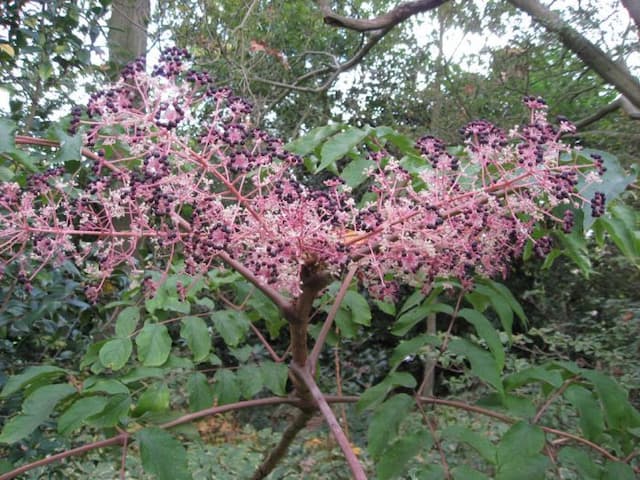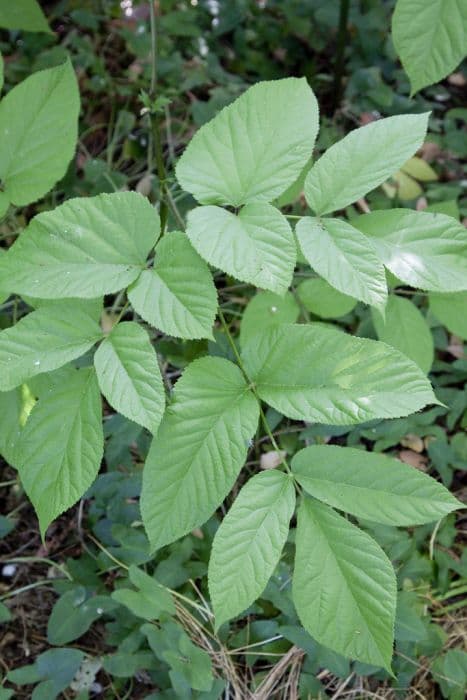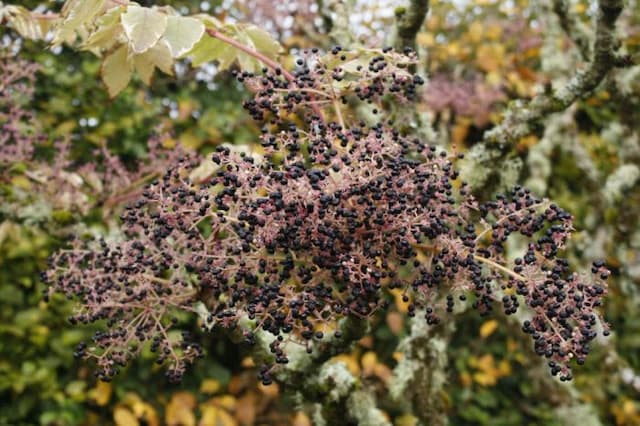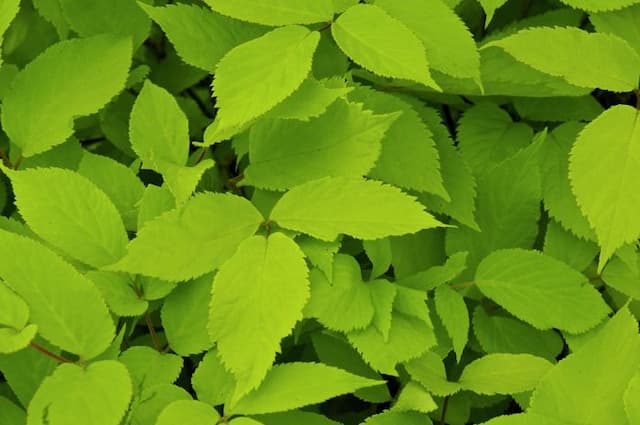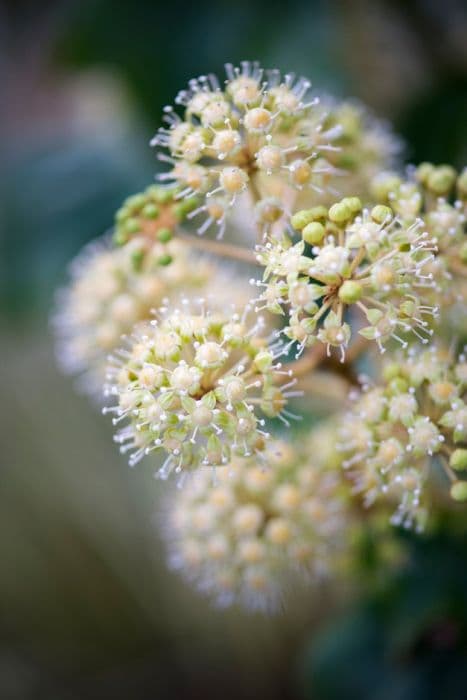English ivy Hedera helix



ABOUT
Hedera helix, commonly known as English ivy, is a woody, evergreen vine that is native to Europe, western Asia, and northern Africa. It is known for its glossy, dark green leaves that are typically 3-5 inches long and 2-4 inches wide. The leaves are simple and have a smooth, wavy edge.
English ivy grows by producing aerial roots that cling to walls, fences, and other surfaces. It can reach heights of up to 100 feet when grown in the right conditions. The plant produces small, greenish-white flowers in the fall, which are followed by small, black berries.
In general, English ivy is a hardy plant that is well adapted to a variety of conditions and can thrive with minimal care. It is often grown as a groundcover or as a climbing plant and is prized for its ability to tolerate shade and add a touch of greenery to areas that are otherwise difficult to grow plants.
About this plant
 Names
NamesFamily
Araliaceae
Synonyms
Common ivy, Bentwood, Bindwood, Common English ivy, Ivory, Ivy gum plant, Love united, Crimean ivy, European ivy, Ivy, Branching ivy, Glacier ivy, Needlepoint ivy, Sweetheart ivy, California ivy
Common names
Hedera acuta, Hedera arborea, Hedera baccifera, Hedera grandifolia, Hedera burgalensis, Hedera caucasigena
 Toxicity
ToxicityTo humans
Hedera helix, or English ivy, is generally considered to be toxic to humans when ingested. The plant contains saponins, which are toxic compounds that can cause digestive problems, vomiting, and diarrhea in humans. In severe cases, ingestion of English ivy can lead to respiratory problems and even death.
It is important to keep English ivy out of reach of children to prevent accidental ingestion. If you suspect that someone has ingested any part of the plant, it is important to seek medical treatment immediately.To pets
Hedera helix is generally considered to be toxic to animals when ingested. The plant contains saponins, which are toxic compounds that can cause digestive problems, vomiting, and diarrhea in animals. In severe cases, ingestion of English ivy can lead to respiratory problems and even death.
It is important to keep English ivy out of reach of pets and children to prevent accidental ingestion. If you suspect that your pet has ingested any part of the plant, it is important to seek veterinary treatment immediately.
 Characteristics
CharacteristicsLife cycle
Perennials
Foliage type
Evergreen
Color of leaves
Greenish-white
Flower color
Green, yellow
Height
Up to 100 feet
Spread
Up to 100 feet
Plant type
Climber
Hardiness zones
4
Native area
Europe, western Asia, northern Africa
Benefits
 General Benefits
General BenefitsEnglish ivy can help reduce noise levels in homes and other buildings by acting as a natural sound absorber;
When grown as a groundcover or as a climbing plant, English ivy can help provide privacy and block out unwanted views;
The plant can help prevent erosion on slopes and other areas where soil is prone to washing away.
English ivy is known for its attractive, glossy leaves and can add a touch of beauty and greenery to any space. Medical Properties
Medical PropertiesHedera helix has been used for medicinal purposes for centuries.
Some of the purported medical properties of English ivy include:
Respiratory health: English ivy has been used to help relieve symptoms of respiratory conditions such as asthma, bronchitis, and colds. It is thought to help reduce inflammation and loosen mucus in the respiratory tract.
Skin health: The plant has been used topically to help treat skin conditions such as eczema and psoriasis. It is thought to help soothe and calm inflamed skin.
Cognitive function: Some studies have suggested that English ivy may have a positive effect on cognitive function and may help improve memory and concentration.
It is important to note that English ivy is generally considered to be toxic when ingested, so it should not be consumed or used internally without the guidance of a healthcare professional. Air-purifying Qualities
Air-purifying QualitiesEnglish ivy is one of the top 10 air-purifying plants, according to the National Aeronautics and Space Administration (NASA). The plant has been shown to help remove toxins and pollutants from the air, including benzene, formaldehyde, and trichloroethylene.
 Other Uses
Other UsesCommon ivy contains compounds that can repel insects, including mosquitoes. The plant can be placed in areas where insects are a problem to help keep them at bay;
The plant can be used to create a natural dye for fabrics and other materials. The plant's leaves and stems contain pigment that can be extracted and used to dye a range of materials, including wool and silk;
Common ivy can be trained to climb up a trellis or other structure to create an indoor climbing area. The plant's aerial roots and dense foliage make it an ideal choice for this purpose;
It can be used as a groundcover to help suppress weeds and to add a touch of greenery to areas that are otherwise difficult to grow plants.
Interesting Facts
 Feng Shui
Feng ShuiIn feng shui, English ivy is often used to enhance the wood element, which is associated with growth, expansion, and creativity. It is believed that placing English ivy in a specific area of the home or office can help to activate the wood element and bring about positive changes in that area.
 Zodiac Sign Compitability
Zodiac Sign CompitabilityGEMINI
English ivy is such a popular houseplant that you'll have no trouble finding one that looks just like yours. Moreover, these plants look great in hanging baskets, which is perfect for this air sign that likes things to be breezy. Plant Symbolism
Plant SymbolismEnglish ivy is often associated with loyalty and fidelity, as it is a plant that clings to its support and grows with great tenacity;
The plant is often used as a symbol of friendship and is often given as a gift to celebrate close relationships;
English ivy is sometimes used as a symbol of love, as it is thought to represent the bonds of love that grow and strengthen over time.
 Water
WaterWhen it comes to watering, it is important to be mindful of the plant's needs and to water it as needed to keep the soil evenly moist, but not waterlogged.
As a general rule, it is a good idea to water English ivy once or twice a week, depending on the conditions. If the plant is grown in a well-draining soil mix and is provided with sufficient light and humidity, it should be able to thrive with this watering schedule.
It is important to avoid letting the soil dry out completely, as this can cause the plant's leaves to wilt and may even lead to the plant's death. At the same time, it is important to avoid overwatering, as this can lead to root rot and other problems. Light
LightIn general, the plant prefers bright, indirect light and will do well in areas that receive a few hours of indirect sunlight per day. It can also tolerate low light conditions and is a good choice for areas that do not receive much natural light.
It is a good idea to place English ivy in an area that receives bright, indirect light, such as near a window that faces east or west. If the plant is placed in a location that receives direct sunlight, it is important to provide some shade to protect the leaves from getting sunburned. Temperature
TemperatureThe plant prefers cool to moderate temperatures and will do well in environments where the temperature ranges from 45-75°F.
It is important to note that English ivy is sensitive to extreme temperatures and may become stressed if the temperature gets too hot or too cold. It is a good idea to protect the plant from extreme temperatures and to provide some shelter if the temperature falls below freezing. Pruning
PruningEnglish ivy is a fast-growing plant that may require pruning to maintain its shape and to control its size. When pruning English ivy, it is important to remove any dead, damaged, or diseased leaves or stems as needed. It is also a good idea to prune the plant to remove any stray or unruly stems that may be growing out of control. In general, it is a good idea to prune English ivy in the spring or early summer, when the plant is actively growing. This will allow the plant to recover from pruning and to regrow any lost foliage.
 Cleaning
CleaningAs needed
 Soil
SoilEnglish ivy is a versatile plant that can grow in a variety of soil types as long as the soil is well-draining. In general, the plant prefers a soil pH that is slightly acidic to neutral, with a pH range of 6.0 to 7.0 being ideal.
When choosing soil for English ivy, it is important to select a soil mix that is well-draining and that will not become waterlogged. A soil mix that contains a combination of peat moss, perlite, and vermiculite is a good choice, as it will provide the plant with good drainage while still retaining some moisture. Repotting
RepottingRepot the plant every two to three years, or as needed to accommodate its growth.
When repotting English ivy, it is important to choose a container that is slightly larger than the current pot and that has drainage holes to prevent the plant from becoming waterlogged. Humidity & Misting
Humidity & MistingEnglish ivy is a relatively low-maintenance plant that is adaptable to a range of humidity levels. In general, the plant prefers moderate humidity levels and will do well in environments where the humidity ranges from 40% to 60%.
If the air in your home or office is particularly dry, you may need to take steps to increase the humidity around the plant to ensure that it is getting the moisture it needs.
To increase the humidity around English ivy, you can mist the plant regularly, use a humidifier or group plants together. Suitable locations
Suitable locationsIndoor
All year round
Outdoor
The plant is a hardy plant that can thrive when grown outdoors in the right conditions.
But to grow English ivy outdoors choose the right location: English ivy prefers a location that receives bright, indirect light and that is protected from strong winds. Also English ivy prefers a well-draining soil mix that is slightly acidic to neutral in pH. And do not forget to water the plant regularly.Hardiness zone
5 - 12 USDA
 Life cycle
Life cycleThe plant has a relatively simple life cycle and can live for many years with proper care.
English ivy begins its life as a small seedling, which will grow into a mature plant over time. As the plant grows, it will produce leaves and stems, and may occasionally produce small, greenish-white flowers that are borne on spikes.
The plant will continue to grow and produce foliage throughout its life, although the rate of growth may slow as the plant matures. English ivy is an adaptable plant that can tolerate a range of growing conditions and can be grown in a variety of environments. Propogation
PropogationPropogation time
Spring
By STEM CUTTINGS:
Choose a healthy stem that is free of disease or pests. Cut off a 4-6 inch section of the stem using a sharp, clean knife or scissors. Remove the lower leaves from the stem cutting, leaving only the top few leaves intact.
Dip the cut end of the stem cutting in rooting hormone to encourage root growth. Plant the stem cutting in a well-draining potting mix and water it well. Place the pot in a location that receives bright, indirect light and maintain the soil moisture.
By LEAF CUTTINGS:
Choose a healthy leaf that is free of disease or pests. Cut off a piece of the leaf using a sharp, clean knife or scissors.
Dip the cut end of the leaf cutting in rooting hormone to encourage root growth. Plant the leaf cutting in a well-draining potting mix or place it in a jar of water. Place the pot or jar in a location that receives bright, indirect light and maintain the soil moisture or change the water regularly.
 Pests
PestsSpider mite, Scale insects, Aphid
 Diseases
DiseasesLeaf spot
